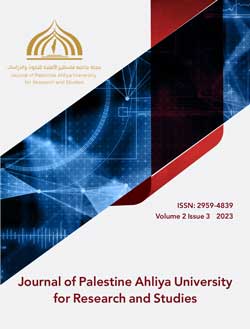Radiographic Positioning Standards for Joint Radiography Quality Assessment at Al Makkased Hospital-Jerusalem
DOI:
https://doi.org/10.59994/pau.2023.3.126Keywords:
Radiography Quality, Radiographic Positioning, Joints, Parallelism, Anatomy, LocationAbstract
The fact that anatomical structures overlap makes imaging the body challenging. Radiograph diagnostic accuracy generally refers to the degree to which an examination can be used to forecast the existence (or absence) of an illness or condition. By supplying diagnostic images, the technologist plays a crucial part in increasing diagnostic accuracy. To isolate and provide a clearer view of a body area being scanned, a technologist must be knowledgeable about the many postures and techniques needed. Different projections not only make anatomical parts easier to perceive, but they also aid in the anatomization of abnormalities and the localization of foreign bodies. This study focused on the precise positioning of patients’ X-rays in the Al-Makkased Hospital emergency room when they reached there as a consequence of various accidents, falls, or other causes. Emergency photos from January to June (2020) were examined as part of our examination of digital radiography (DR) imaging, and problems with the photos were discovered. Our research revealed that the percentage of examination errors is just 14.6%, which is not a very significant number. The four joints that were evaluated in this investigation were the elbow, wrist, knee, and ankle. The three fundamental flaws that were examined while assessing projections were parallelism, location, and anatomy additional exposure errors were also found. Specifically, this project discussed standards for joint radiography quality, technique, framework, structure, and findings.
Downloads
References
Auberson, L., Beaulieu, J. Y., & Bouvet, C. (2020). Radiology of the hand and wrist for the general practicioner. Revue medicale suisse, 16(700), 1380-1387.
Campbell, E. A., & Wilbert, C. D. (2017). Foreign body imaging. In: StatPearls. StatPearls Publishing, Treasure Island (FL); 2022. PMID: 29262105.
Chen Zhou, Z. H., Martínez Chamorro, E., Ibánez Sanz, L., Sanz De Lucas, R., Chico Fernández, M., & Borruel Nacenta, S. (2022). Traumatic arterial injuries in upper and lower limbs: what every radiologist should know. Emergency Radiology, 29(4), 781-790.
Hendrix, R. W., Urban, M. A., Schroeder, J. L., & Rogers, L. F. (1987). Carpal predominance in rheumatoid arthritis. Radiology, 164(1), 219-222.
Husseini, J. S., Chang, C. Y., & Palmer, W. E. (2018). Imaging of tendons of the knee: much more than just the extensor mechanism. The Journal of Knee Surgery, 31(02), 141-154.
Kei, W., Hogg, P., & Norton, S. (2014). Effects of kilovoltage, milliampere seconds, and focal spot size on image quality. Radiologic technology, 85(5), 479-485.
Kjelle, E., & Chilanga, C. (2022). The assessment of image quality and diagnostic value in X-ray images: a survey on radiographers’ reasons for rejecting images. Insights into Imaging, 13(1), 1-6.
Kong, A. P., Robbins, R. M., Stensby, J. D., & Wissman, R. D. (2022). The Lateral Knee Radiograph: A Detailed Review. The Journal of Knee Surgery, 35(05), 482-490.
Martin, C. J., Sutton, D. G., & Sharp, P. F. (1999). Balancing patient dose and image quality. Applied radiation and isotopes, 50(1), 1-19.
Lehnert, T., Naguib, N. N., Korkusuz, H., Bauer, R. W., Kerl, J. M., Mack, M. G., & Vogl, T. J. (2011). Image-quality perception as a function of dose in digital radiography. AJR-American Journal of Roentgenology, 197(6), 1399.
Schibilla, H., & Moores, B. M. (1995). Diagnostic radiology better images--lower dose compromise or correlation? A European strategy with historical overview. Journal belge de radiologie, 78(6), 382-387.
Sutter, J. M., Johnsen, U., Reinhardt, A., & Schönheit, P. (2021). Correction to: Pentose degradation in archaea: Halorhabdus species degrade D-xylose, L-arabinose and D-ribose via bacterial-type pathways. Extremophiles, 25, 527-527.
Tapiovaara, M. J. (2008). Review of relationships between physical measurements and user evaluation of image quality. Radiation protection dosimetry, 129(1-3), 244-248.
Tucker, D. M., Barnes, G. T., & Chakraborty, D. P. (1991). Semiempirical model for generating tungsten target x‐ray spectra. Medical physics, 18(2), 211-218.
Udupa, H., Mah, P., Dove, S. B., & McDavid, W. D. (2013). Evaluation of image quality parameters of representative intraoral digital radiographic systems. Oral surgery, oral medicine, oral pathology and oral radiology, 116(6), 774-783.
Wang, S., Xiao, Z., Lu, Y., Zhang, Z., & Lv, F. (2021). Radiographic optimization of the lateral position of the knee joint aided by CT images and the maximum intensity projection technique. Journal of Orthopaedic Surgery and Research, 16(1), 1-7.

Downloads
Published
How to Cite
Issue
Section
License
Copyright (c) 2023 Journal of Palestine Ahliya University for Research and Studies

This work is licensed under a Creative Commons Attribution 4.0 International License.
مجلة جامعة فلسطين الاهلية للبحوث والدراسات تعتمد رخصة نَسب المُصنَّف 4.0 دولي (CC BY 4.0)











